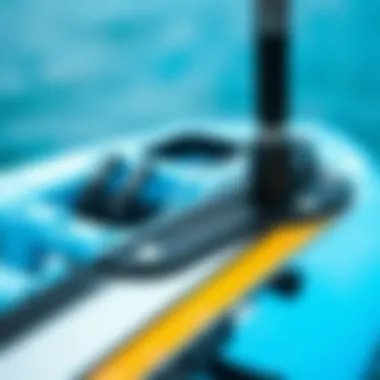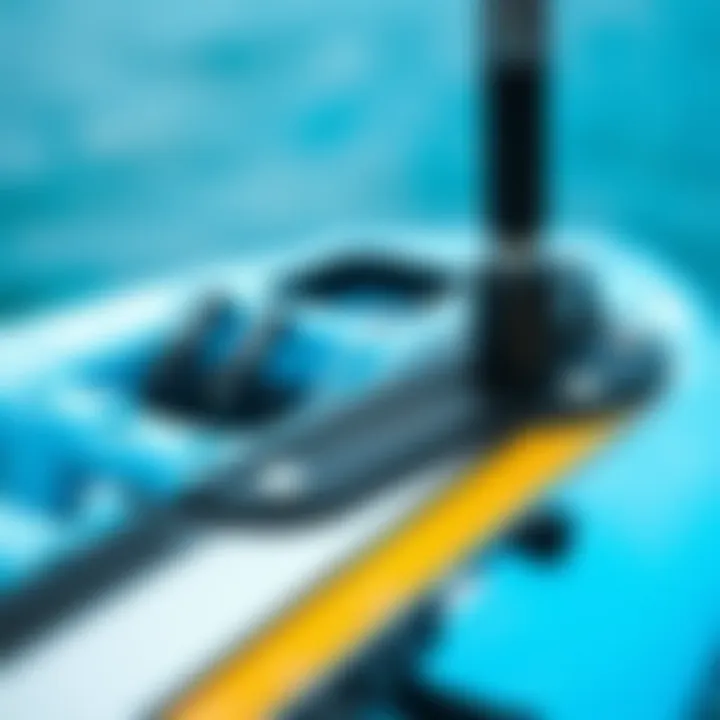The Rise of Powered Foil Surfboards: A Comprehensive Exploration


Intro
The world of water sports has seen remarkable innovations, and powered foil surfboards are at the forefront of this evolution. While traditional surfing offers a pure connection to the waves, the addition of motorized assistance opens doors to new realms of riding. These boards, which lift out of the water on a hydrofoil, offer not only thrilling experiences but also unique challenges and learning curves.
What sets these surfboards apart is their design and functionality. The mechanics behind powered foil surfboards involve complex engineering, yet the user experience often feels deceptively simple. Both novices and seasoned riders are increasingly drawn to the thrill of soaring above the waves, making powered foiling a hot topic in the water sports community.
In this comprehensive exploration, we'll delve into the evolution of these boards and discuss the specific mechanics that make them tick. From the essential gear you'll need to get started to advanced techniques for those ready to take their skills to the next level, we've got you covered. Safety considerations, community involvement, and future trends will also find their place in this narrative, providing a well-rounded view of this exciting sport.
So, whether you're just dipping your toes into the surfing world or looking to refine your tricks and techniques, this guide aims to be your go-to resource.
Gear and Equipment
When stepping into the realm of powered foil surfing, understanding the necessary gear is crucial. Unlike traditional surfboards, powered foils require specific equipment tailored to their unique features and performance requirements.
Essential Gear for Newcomers
For those venturing into powered foiling for the first time, it's essential to start with the right foundational gear. Here are the key components:
- Powered Foil Surfboard: Look for boards that balance weight, buoyancy, and hydrodynamics. Depending on your size and skill, finding the right board is paramount.
- Hydrofoil Section: This is the heart of the powered surfboard. A well-designed hydrofoil influences stability and lift.
- Remote Control: This device allows the rider to operate the board from a distance, giving flexibility in maneuvering.
- Safety Gear: A life jacket, helmet, and impact vest are advisable, especially for beginners who are still mastering control.
Before heading into the water, familiarize yourself with the equipment. Knowing how each component works together can significantly enhance your riding experience.
Advanced Equipment for Experienced Riders
As riders become proficient, the need for specific advanced gear arises:
- Custom Foils: Experienced riders might prefer foils that can be adjusted for different conditions, boosting performance and adaptability.
- Enhanced Battery Systems: Upgraded batteries can offer longer ride times and improved power efficiency, key for those who want to maximize their sessions.
- Specialized Wetsuits: Consider suits designed for buoyancy and flexibility, allowing for more comfortable long rides or colder waters.
Investing in quality gear tailored to your level can truly transform your time on the water. As you progress, keeping up with the latest developments and trends in equipment will ensure you remain ahead in this sport.
"The right gear not only enhances performance but also elevates the overall experience of powered foiling."
As we navigate through the mechanics and techniques of powered foil surfing, understanding the gear is just the beginning. Let's explore the skills needed to ride effectively.
Prolusion to Powered Foil Surfboards
The rise of powered foil surfboards marks a notable shift in the landscape of water sports, transforming how enthusiasts engage with the waves. These surfboards, equipped with hydrofoils and electric motors, elevate the rider above the water's surface, offering a unique and exhilarating experience that traditional boards cannot replicate. This section is critical not only for understanding powered foil surfing but also for appreciating its impact on the broader industry, including insights into technology, user experience, and safety considerations.
Exploring powered foil surfboards reveals multiple advantages. First off, they allow riders to glide smoothly over choppy waters, providing a sense of freedom similar to flying. This fluidity can encourage many to take to the water, breaking down physical limitations usually seen in traditional surfing. Moreover, these boards are optimized for various skill levels, which means both novices and veterans can harness their thrill—think of it as leveling the playing field in the surfing realm.
In practical terms, users enjoy enhanced performance metrics, such as improved speed and agility, paired with low-impact features that can contribute to a more enjoyable session. But aside from the thrills, acknowledging safety measures, best practices, and the evolving regulations surrounding powered foil surfing should not be overlooked.
In this introduction, we further dissect the foundational elements shaping powered foil surfboards while delving into their brief history, setting the stage for a more intricate analysis in subsequent sections.
Defining the Powered Foil Surfboard
To grasp the complexities of powered foil surfboards, it’s essential to define what sets them apart. A powered foil surfboard combines traditional surfing elements with modern technology. Specifically, it features a hydrofoil mounted below the board, which lifts the rider out of the water as speed increases. This apparatus allows for minimal drag, enabling the rider to travel at higher speeds with less effort.
The integration of an electric motor adds another layer of innovation, providing a consistent and reliable thrust that helps in maintaining momentum even in less than ideal wind or wave conditions. A fundamental characteristic of powered foil surfboards is the battery unit, responsible for powering the motor. Battery longevity and performance are becoming more sophisticated, allowing users to ride for significant durations and enjoy longer sessions without constantly monitoring their charge.
History of Foil Surfing
The origins of foil surfing can be traced back to the early 2000s. Its foundation lies in the desire to create an alternative form of surfing that transcends the limitations typically experienced on a surfboard. Pioneers like Laird Hamilton kick-started this movement, exploring the potential of hydrofoil technology as they experimented with different designs and configurations on Oahu's waters.
During the initial phase, foil surfing was a niche activity, capturing the interest of only a select few. However, innovations in materials and technology led to greater accessibility. Over the years, advancements transformed the concept from an experimental endeavor into a legitimate sport. The arrival of powered foil surfboards expanded this horizon, encouraging broader participation by eliminating the reliance solely on the power of natural waves.
As we analyze the journey of foil surfing over the years, it becomes clear how pivotal it has been in diversifying water sports while fostering a community that appreciates both the artistic and athletic elements of riding. It paved the way for the development of powered models, showcasing a blend of heritage and modernity that continues to entice riders today.
Core Components of Powered Foil Surfboards
Understanding the core components of powered foil surfboards is like unlocking the mechanics of a complex clock. Each element works together, creating a seamless riding experience that is powerful, yet controlled. A deep dive into these components reveals not just how they contribute to performance, but also their significance in enhancing rider experience and safety.
In this section, we'll explore three pivotal elements: foil design and materials, power units, and board construction, discussing their unique characteristics and how they impact overall surfboarding dynamics.
Foil Design and Materials
Hydrodynamics
Hydrodynamics in foil surfing involves the study of how water interacts with the board's structure. This critical aspect informs the design of the foils. A well-designed foil enables surfers to ride on the surface of the water, reducing drag and increasing speed. The key characteristic here is efficiency; a streamlined design allows for smoother transitions through various water conditions.


The unique feature of modern hydrodynamic foils lies in their angle of attack and aspect ratio. Higher aspect ratios often improve lift, allowing the board to rise above the water with minimal resistance. However, this comes with a slight disadvantage—greater sensitivity to balance, requiring riders to develop precise control.
Material Characteristics
Material characteristics play a substantial role in the durability and performance of powered foil surfboards. Most foils are made from materials like carbon fiber or aircraft-grade aluminum, allowing them to withstand the rigors of sport while still being lightweight. The key characteristic here is strength-to-weight ratio, which is crucial for both endurance and responsiveness.
A standout aspect of these materials is their resistance to corrosion and impact. Carbon fiber, for instance, not only offers superior strength but also helps dampen vibrations, creating a more comfortable ride. On the flip side, the downside to using high-end materials can often be the cost.
Power Units
Battery Lifespan
One of the significant aspects of power units in powered foil surfboards is battery lifespan. This refers to how long a battery can sustain power during use. It's crucial, as longer battery life means extended surfing sessions without interruptions. The key characteristic of a good battery lies in its capacity and charge time.
Most users find lithium-ion batteries to be optimal due to their efficiency and durability. However, the unique feature is their ability to charge quickly—many modern batteries allow riders to be back on the water in just a couple of hours. Yet, they can lose effectiveness over time, which is something buyers should keep in mind.
Motor Configurations
Motor configurations are another vital component dictating performance. The way motors are arranged within the board can greatly influence functionality. Typically, a single motor setup offers simplicity, while dual motors can deliver enhanced power and control, providing a smoother ride in turbulent waters.
A noteworthy feature of advanced motor configurations is their quiet operation. Riders can enjoy the serenity of water without the noisy distraction associated with older models. However, complex setups like dual motors require more maintenance, which may not suit all riders.
Board Construction
Weight Distribution
Weight distribution in powered foil surfboards significantly affects balance and maneuverability. Good distribution allows for controlled rides, particularly in choppy waters. The key characteristic of weight distribution pertains to achieving a centralized balance point, ideal for maintaining stability.
The unique feature of innovative weight distribution lies in adjustable fins or ballast systems, which enable riders to tweak and refine their balance based on conditions. The disadvantage? Achieving perfect setup often requires trial and error, something beginners might find frustrating.
Durability Factors
Durability factors look into how well the board withstands everyday wear and tear. Materials used in construction must resist impacts, scratches, and environmental factors such as saltwater erosion. A critical characteristic here would be layering techniques that provide robustness without a hefty weight.
Foam cores with high-density skins, for instance, enhance durability in powered boards. Additionally, the construction methodology—be it sandwich construction or molded—also plays a part. While a tougher build safeguards against damage, heavier boards can be more cumbersome in the water.
In essence, understanding the core components of powered foil surfboards is paramount for both new and seasoned surfers. By focusing on hydrodynamics, material characteristics, power units, and construction, enthusiasts can make informed decisions that lead to an enhanced surfing experience.
Mechanics of Operation
Understanding the mechanics of operation is crucial when you're diving into the world of powered foil surfboards. Not only does it illuminate how these boards work, but it also highlights the innovations that make this sport accessible to both novices and seasoned pros. With the rapid technological advancements and increasing popularity of powered foil surfing, it's become evident that learning how these boards function can significantly enhance user experience and safety.
How Powered Foil Surfboards Function
Powered foil surfboards utilize an intricate blend of hydrodynamics and advanced engineering principles to provide a smooth gliding experience over water. At the heart of their functionality lies the foil itself, which consists of a wing-like structure submerged beneath the surface. When a rider accelerates, the lift generated by the foil elevates the board above the water, reducing drag and allowing for remarkable speeds. The e-motor propels the board, maintaining speed while enabling maneuverability.
Here's a straightforward breakdown of how these boards operate:
- The rider utilizes a remote control to manage power output.
- As the rider gains speed, the foil begins to generate lift.
- Once sufficient lift is achieved, the board elevates, creating an exhilarating experience that combines aerial freedom with surfing.
- Riders can adjust their stance and weight distribution to maintain balance and control the board's altitude.
It's a blend of physical skill and technical understanding, making it a sport that requires both technique and adaptive learning.
User Control Systems
The user control system of powered foil surfboards plays a vital role in enhancing the surfing experience. These systems encompass the remote controls and safety mechanisms, allowing for seamless operation and user engagement, ensuring that both novices and experts can enjoy the thrill of powered foiling.
Remote Control Features
Remote control features are one of the standout aspects of powered foil surfboards. These controllers allow riders to adjust throttle and direction, providing the precision needed to navigate water conditions effectively. A distinctive characteristic of these remotes is their wireless connection, which offers freedom of movement without cumbersome cords getting in the way.
One key benefit of remote controls is ease of use. Most systems are designed with user-friendly interfaces, enabling even beginners to get accustomed to controlling speed and direction quickly. However, there are downsides, such as the reliance on battery power. If the remote runs out of juice, the user risk losing control, which could compromise safety.
Safety Mechanisms
Safety mechanisms integrated into powered foil surfboards are essential for ensuring a secure riding experience. These measures include automatic cutoff systems that halt the motor if the rider falls, reducing the chance of injuries. A notable feature is the leash system, which connects the rider to the board, ensuring the board doesn't drift away in case of a wipeout.
The importance of these safety features cannot be overstated. They are designed to protect users from potential accidents that can arise from unpredictable conditions or skill lapses. Yet, while such mechanisms may instill confidence in riders, they are not foolproof. An understanding of the limitations and conditions for reliance on these safety measures is necessary for effective use.
Overall, the mechanics of operation for powered foil surfboards blend advanced technology with user-centric design, fundamentally reshaping the surfing landscape. Keeping a keen eye on the developments in this realm will only enhance the experience for water sport enthusiasts.


Performance Analysis
Performance analysis is a crucial element to understand how powered foil surfboards stand out in the ever-evolving landscape of water sports. What really makes these boards tingle with potential is the intricate balance of speed, agility, stability, and handling performance. This section delves into what sets these advanced surfboards apart from traditional counterparts, and why these factors can make or break the user’s experience.
Speed and Agility Comparisons
When we talk about speed in powered foil surfboards, we are not just throwing around numbers; we are diving into how design influences performance. Unlike traditional surfboards which are limited by the surfer's paddling strength and the ocean's waves, powered foils can reach impressive speeds with minimal effort. Some models can hit up to 25 miles per hour or more, making them a thrilling option for speed enthusiasts. The electric motor lifts the board out of the water, reducing drag and allowing for a seamless glide.
Agility is another dimension where powered foils shine. The ability to take sharp turns or accelerate quickly without losing control is essential, especially in congested waters. The design of the foil plays a vital role here. The placement of the wings, along with the shape and size, can either enhance or diminish a rider’s ability to perform tricks and maneuvers.
Consider the differences in foil shape: a larger wing might offer stability, but it can also limit maneuverability at higher speeds. Meanwhile, a more aggressive wing contour can boost agility but risks increased instability. Riders must know what they want in terms of experience, as this will heavily affect their choice of equipment.
Stability and Handling
Stability is one of the markers that can set a good ride apart from a harrowing experience. No one wants to be flung off their board like a ragdoll. Here, the design and user’s skill come together. A well-balanced foil surfboard can maintain a steady course, even in choppy waters or when making sudden moves. Riders should pay attention to the weight distribution and how it affects handling.
A powered foil board with a low center of gravity can provide a more steady ride. This is especially significant for newcomers, who may find the initial learning curve steep. In fact, many may prefer boards designed for maximum stability as they fine-tune their skills.
Handling also encompasses how user-friendly the control systems are. The integration of intuitive control systems into powered foil surfboards simplifies operation and increases safety. Whether it’s responsive acceleration or easy deceleration, these aspects help riders navigate through various conditions without losing confidence. Understanding these factors is key for anyone looking to get into powered foil surfing.
"In the world of powered foil surfing, performance isn’t just about pushing your limits; it’s about understanding the nuances that allow you to embrace them responsibly."
Safety and Regulations
The advent of powered foil surfboards is changing the face of water sports. However, with innovation comes responsibility. Discussing safety and regulations is not just a formality; it’s essential. As more enthusiast get behind the controls of these powerful machines, understanding how to operate them safely ensures not only the enjoyment but also the longevity of the sport. This section will explore important elements of safety gear, best practices, and legal considerations surrounding powered foil surfing.
Safety Gear and Best Practices
Impact Vests
Impact vests are becoming a common sight on the water, and for good reason. These vests are designed to offer protection to riders in case of falls or collisions. A key characteristic of impact vests is their ability to absorb shock from impacts, thereby reducing the risk of injury. They are popular among powered foil enthusiasts because they provide both buoyancy and protection, which is vital in a sport where sudden crashes can happen.
One unique feature of impact vests is their multi-layered structure, which not only offers protection but also maintains a slim profile for mobility. This is particularly advantageous for powered foilers who need to navigate quickly and efficiently through water. While they offer significant protection, one disadvantage is that they might not keep you as warm as thicker wetsuits, especially in colder waters. It’s a trade-off that participants must consider, depending on local conditions.
Helmet Usage
Helmets play an equally crucial role in protecting users while they ride powered foil surfboards. The most vital aspect of helmet usage is head protection; in a sport that combines speed and potential for sudden falls, a helmet can mitigate the risk of serious head injuries. Many riders opt for helmets that are lightweight yet robust, allowing for comfortable wear over extended surfing sessions.
An interesting characteristic of modern helmets is their additional features, like built-in visors or removable padding for humidity management. These features enhance the rider's experience, keeping them focused on performance. However, one must note that wearing a helmet can sometimes feel cumbersome, particularly if it's not fitted correctly, impacting overall comfort. Yet, the risk of going without one far outweighs the inconvenience.
Legal Considerations
Navigating Watersports Laws
Understanding watersports laws is critical for powered foil surfing. These laws vary greatly by region and may dictate where and how powered foil surfing can occur. This aspect is vital since it helps enthusiasts stay compliant with local regulations while enjoying their sport. A key characteristic of these laws is that they often prioritize safety and environmental preservation, ensuring that the activities do not infringe upon the rights or safety of others on the water.
The advantage of being knowledgeable about these laws is that it promotes a responsible riding culture among all users. However, one challenge is that these regulations can often be complex, leaving enthusiasts unsure about certain limitations or requirements. Seeking local governing bodies' guidelines or advice from veteran surfers can help navigate these complexities more comfortably.
Environmental Regulations
Environmental regulations are increasingly relevant in the context of powered foil surfing, particularly as concerns over water pollution and habitat destruction grow. These regulations play a crucial role in safeguarding aquatic ecosystems while allowing recreational activities to coexist with nature. A defining characteristic of environmental regulations is their aim to minimize the impact of human activity on natural habitats, promoting sustainability in water sports.
One unique feature of these regulations is that they often include specific guidelines on emissions from powered devices and the types of watercraft allowed in sensitive areas, like marine reserves. The advantage is that these rules encourage environmentally friendly practices, fostering greater respect and care for the ocean. On the downside, these laws can sometimes feel restrictive, limiting where a powered foil enthusiast can freely enjoy their sport, which can be frustrating for some riders.
Remember, following safety gear recommendations and understanding legal framework not only ensures your protection but also contributes to the longevity and integrity of the sport for others.
Comparative Landscape
The realm of surfboards has shifted immensely in recent years, with powered foil surfboards making notable waves. This section elucidates the comparative landscape between traditional surfboards and powered foil surfboards, spotlighting their respective advantages and considerations.
Traditional Surfboards vs Powered Foil Surfboards
While traditional surfboards have long represented the sport's essence, powered foil surfboards introduce a new dimension altogether. The age-old craft, with its various shapes and materials, relies heavily on paddle power, wave selection, and rider skill. Traditional boards excel in their simplicity and connection to the ocean, which many surfers hold dear. At the same time, they often require specific wave conditions and can be limiting for those seeking to ride outside of peak surfing locations.
In contrast, powered foil surfboards open the doors to a broader range of experiences.
Here are some key differences to consider:
- Wave Independence:
Powered foil surfboards can glide above the water at higher speeds. They are less reliant on breaks and can be used in flatter waters without consistent waves. This means greater freedom to explore and enjoy the ocean in various conditions. - Learning Curve:
For newcomers, powered foil boards may seem less intimidating because they allow faster learning of balance and control without needing to catch a wave. They provide an easier entry point to the sport for interested individuals. - Technology and Efficiency:
The mechanics of powered foil boards involve the integration of batteries and motors, showcasing a blend of traditional craftsmanship with modern technology. This shift raises new questions around sustainability and power management.
"The rise of powered surfboards challenges traditional norms, creating a platform for diverse surfing experiences."
Anonymous Surfer


Emerging Technologies in Water Sports
As powered foil surfboards gain traction, they signify a larger trend within water sports towards integrating advanced technologies. Autonomous navigation systems, enhanced battery designs, and smart wearable tech are emerging alongside these boards. Each of these innovations presents unique possibilities:
- Autonomous Features:
Some advanced powered surfboards are incorporating smart control systems that make them easier to operate, with features like speed regulation and location tracking. - Battery Advancements:
Improved batteries are extending usage time and reducing the need for frequent recharges. Developments in lithium-ion technology are paving the way for lighter, more potent power units. - Eco-friendly Initiatives:
The future hinges on sustainability. Brands are actively researching environmentally safer options for materials and power sources, striving to minimize the ecological footprint of powered surfing.
Overall, the comparative landscape offers a fertile ground for discussion. Those interested in kiteboarding, outdoor activities, and travel shouldn't overlook these changes, as the blend of technology and water sports continues to evolve rapidly.
Community and Culture
Community and culture play a vital role in the world of powered foil surfboarding. The advent of this innovative sport has fueled a collective enthusiasm, uniting individuals who share a passion for water sports and adventure. This camaraderie fosters an environment where knowledge, experiences, and techniques are exchanged, significantly enhancing the overall experience for both newcomers and seasoned riders. A well-knit community not only provides technical know-how but also cultivates a sense of belonging which can be missing in many other pursuits.
When enthusiasts gather, whether on local beaches or online forums, the opportunities for learning and growth multiply manifold. The sharing of tips—from selecting the right gear to mastering tricky maneuvers—creates a rich landscape for personal and community improvement. This emphasis on support and education often transforms casual riders into highly skilled surfers, thus lifting the overall standard of the sport.
Fostering a Community of Enthusiasts
Fostering a community specifically centered around powered foil surfboarding is akin to building a sturdy foundation that's crucial for any sport. There are several ways enthusiasts bring one another together, and electronic platforms play a considerable role. Social media platforms, such as Facebook and Reddit, encourage discussions ranging from gear optimizations to sharing exhilarating experiences. Specialized groups and pages facilitate real-time interactions, helping riders form friendships beyond geographical limits.
In local circles, clubs and meet-ups do wonders for bonding. Here, riders participate in shared activities ranging from casual sessions to organized practice drills. These events often stir up friendly competitions and camaraderie, motivating members to better themselves—one ride at a time. Moreover, the presence of such clubs offers newer surfers a mentorship system that significantly eases their entry into the sport.
Events and Competitions
Every sport thrives on events and competitions, and powered foil surfing is no different. These occasions are more than just showcases of skill; they serve as celebrations of the sport itself. Competitions can range from local contests to international championships, often serving as platforms for emerging talent. Riders get the chance to demonstrate their skills, while also learning from each other’s techniques and innovative moves.
Participating in events engenders a spirit of healthy rivalry, fostering both personal and collective improvement within the community. Well-organized events not only display remarkable feats of athleticism but also highlight the growing popularity of powered foil surfboarding. Organizers often incorporate panels where professionals speak about their experiences and offer insights into the future of the sport.
In summary, community and culture are not just beneficial; they are essential for the sustained growth of powered foil surfing. By nurturing these aspects, enthusiasts can help establish a supportive foundation, ultimately ensuring that the sport not only survives but thrives in the years to come.
"Community is at the heart of every successful sport; without it, we are just solitary riders on the water."
To dive deeper into the vast resources available to powered foil surfers, explore forums on Reddit or connect with passionate individuals on Facebook for discussions and sharing of experiences.
Future Trends and Innovations
The landscape of powered foil surfing is not static; it is a dynamic interplay of technology, design, and user demands. This section explores the future trends and innovations that hold the potential to redefine the sport. Understanding these trends is essential for enthusiasts, manufacturers, and anyone vested in the future of water sports. From anticipated design enhancements to the way electric power reshapes the experience, there is much to dissect as we stand on the cusp of a new era in surfing.
Anticipated Developments in Design
The design of powered foil surfboards is bound to evolve as technology advances and user feedback becomes more integrated into production. Future designs may focus more on ergonomics and usability. The goal will be to enhance performance while ensuring comfort during extended use. This can lead to lighter materials and improved hull shapes that cater to various skill levels, making the sport more accessible to newcomers without sacrificing performance for seasoned riders.
Some key aspects to watch out for include:
- Advanced Materials: Innovations in composite materials could yield lighter and stronger boards. Carbon fiber and other composites might dominate, providing durability without adding bulk.
- Hydrodynamic Improvements: The design of the foils may see unprecedented changes with more focus on reducing drag, allowing for greater speeds with less power consumption. This can make riding more efficient and thrilling simultaneously.
- Customizable Options: As personalization becomes a trend in many sports, we might see boards designed to accommodate individual riders’ preferences regarding weight distribution, size, and riding style.
There is a palpable excitement among designers, with hints of concepts that may emerge from R&D depending on advancements in technology coupled with environmental considerations. However, the integration of technology must go hand-in-hand with sustainability practices, pushing the industry into a greener future.
The Impact of Electric Power on Surfing
Electric power is a game changer. It removes some of the barriers that conventional surfboards face, notably the dependence on waves, wind, and perfect climatic conditions. As a result, powered foil surfing allows enthusiasts to ride in diverse environments that were previously unusable.
Several factors underline the influence of electric power on control, accessibility, and opportunities:
- Increased Accessibility: Riders can enjoy surfing in locations with minimal or no waves, allowing them to practice and enjoy the sport year-round. This opens the door for many areas across the globe.
- User-Friendly Experience: Enhanced control systems powered by electricity make these boards easier to handle. Beginners can learn at a more gradual pace, while experts can fine-tune their experience. As technology advances, we may see more intuitive control systems that adapt to the rider's skills.
- Sustainability Focus: As electric power sources improve, we might see a shift towards more eco-friendly models, utilizing renewable energy sources. This may lead to companies prioritizing sustainability in every aspect of production and operation.
“The future of powered foil surfing is entwined with the innovations in electric technology, steering the sport toward a more inclusive and sustainable path.”
With electric power redefining surfing, there are both challenges and opportunities. Stakeholders in this space must navigate the implications, ensuring they embrace new technologies responsibly while delivering an exhilarating experience for users. As these trends continue to develop, they signify the importance of adaptability and foresight in the expanding world of powered foil surfboards.
Epilogue
As we reach the end of our journey into the world of powered foil surfboards, it's essential to reflect on the key elements, benefits, and considerations highlighted throughout this exploration. The rise of powered foil surfboards is not just a trend; it symbolizes a profound shift in how enthusiasts engage with water sports.
Summarizing Key Takeaways
- Evolution of Design: The design of powered foil surfboards has progressed significantly, incorporating advanced materials and technology. This ensures greater durability, enhanced speed, and a more exhilarating surfing experience.
- User Experience: Whether you are a neophyte or a seasoned surfer, the user experience varies widely. Understanding the components, such as foil design and power units, greatly influences your handling and overall enjoyment.
- Safety and Regulation: With the innovations in this sport comes a responsibility to adhere to safety practices and regulations. Proper gear and awareness of local laws are vital for a safe experience on the water.
- Community and Culture: The community of powered foil enthusiasts is thriving, fostering unity and shared passion for the sport. Competitions and events play a pivotal role in building camaraderie and pushing the boundaries of what’s possible.
- Future Prospects: The continued advancements in electric and battery technologies hint at a bright future. Innovations are expected to further enhance performance, safety, and accessibility, ensuring powered foil surfing remains attractive to new and experienced riders alike.
Final Thoughts on the Evolution of Foil Surfing
The evolution of foil surfing extends beyond mere recreation; it reflects a broader dialogue about sustainability and technology in the outdoor sports realm. As powered foil surfboards continue to gain traction, they challenge traditional notions of what surfing means and how it is experienced. This sport encourages an adventurous spirit, pushing individuals to test their limits while respecting the environment they enjoy.
With innovation at its core, the powered foil surfboard represents not just equipment, but a community fueled by passion, creativity, and a commitment to pushing beyond the horizon. As we look ahead, anticipating future developments in design and technology, it is clear that powered foil surfing holds an exciting promise for water sports aficionados the world over.
"The sea is a world of its own, reshaped by those fearless enough to embrace the waves of change."
Whether you're contemplating your first ride or seeking to refine your skills, the universe of powered foil surfing is replete with opportunities to connect, explore, and elevate your experience. The ride ahead is as thrilling as the waves themselves.















